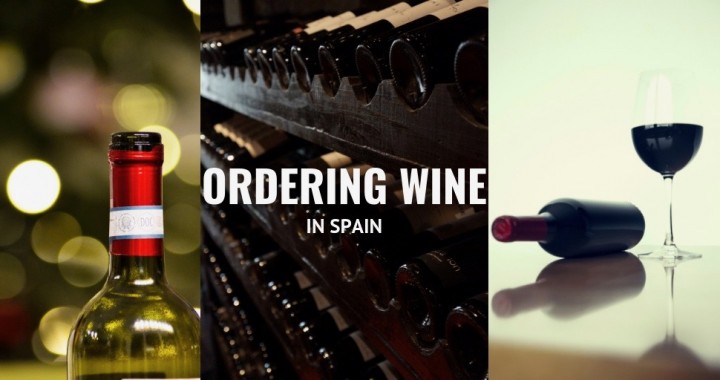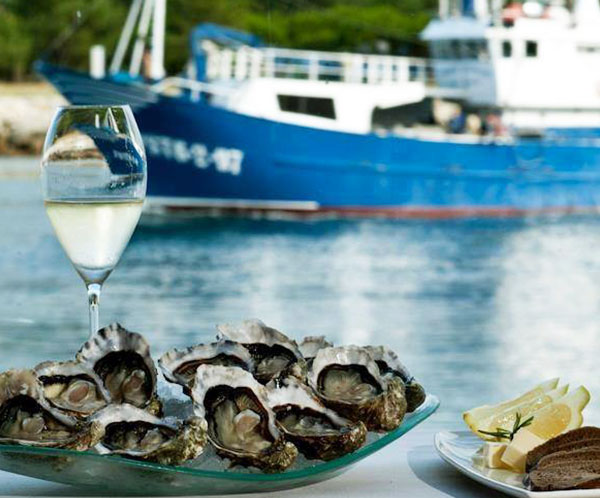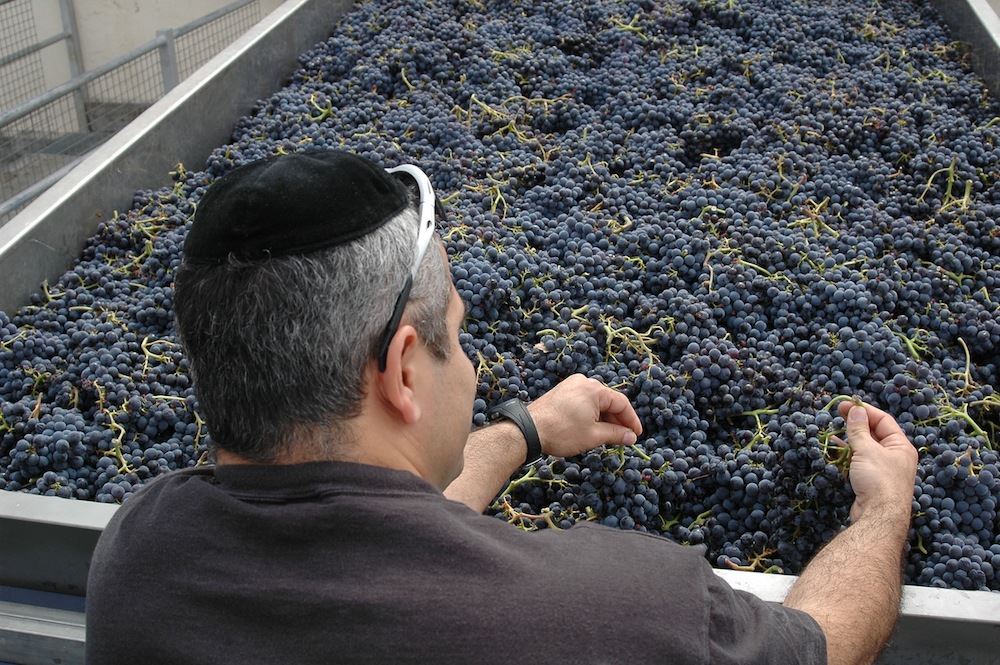Ordering wine in Spain. From the rustic taverns to the elegant Michelin-starred restaurants, wherever you go in Spain, you’ll want to order and enjoy amazing wines. Here at Totally Spain, when we’re not busy organising custom Spain and Portugal tours for our clients, we’re lucky enough to be able to sample and savour great wines. Here are some of our practical tips and general insights into ordering wine in Spain.
Ordering Wine in Spain
1 What’s On a Wine List in Spain
So, ordering wine in Spain? No prizes for guessing that every wine list will be divided into reds & whites called ‘tintos’ and ‘blancos’ with a side-section for cavas, champagnes and rosés called ‘rosados’.
Not sure what to go for when ordering wine in Spain? Well, here it is typical to choose a white wine for seafood and a red for the richer meatier dishes. But it’s never frowned upon if you side-step this and drink white with meat or red with fish. The default wine in Spain is red as you’ll see in the bars and restaurants. During the warmer Summer months, you might want to try a ‘rosado’ with one of your meals. And if you’re looking for something bubbly, prosecco is available here in most restaurants but we’d recommend ordering a cava brut or brut nature.
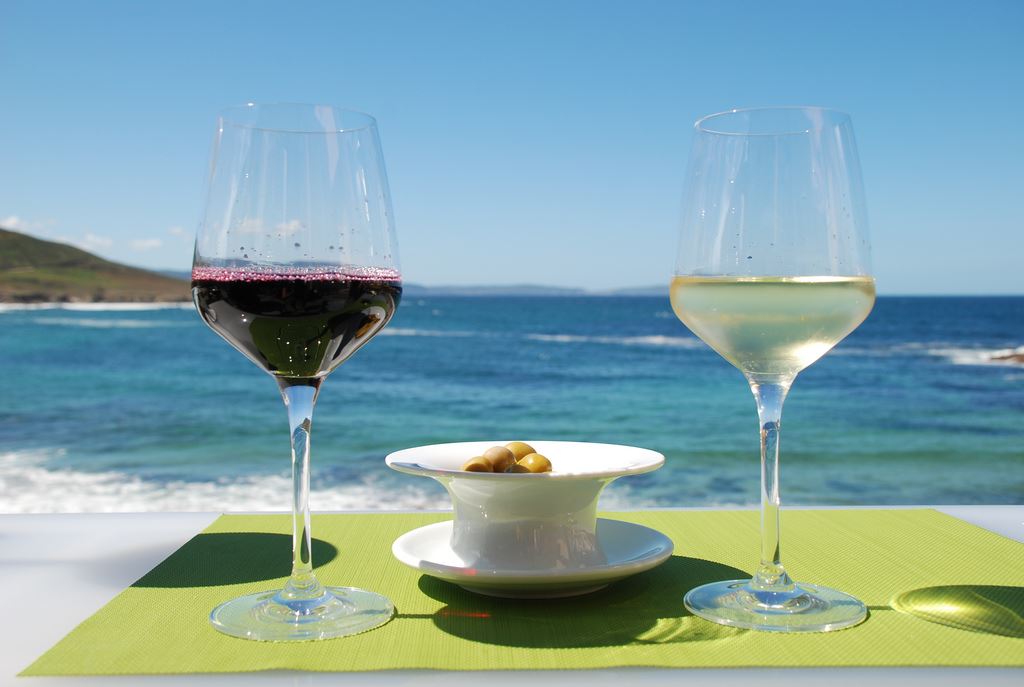
Wine in Spain is never poured more than half-way up the glass. Photo credit: Caión 3 via photopin (license)
2 What’s Not On a Wine List in Spain
If you are hankering after a sangria – you will rarely find it on a wine list. You’ll have to ask the serving staff whether it’s available. It’s something you rarely see Spanish diners order – but when freshly made, and sitting on a terrace or garden it’s hard to beat for a refreshing glass of summer-ness.
House wines are also something that you don’t find on wine lists is Spain. The concept of buying inexpensive wine in bulk does exist but these house wines are usually served with fixed-price meals called ‘menus del dia’. If you are having a ‘menu del dia‘ you are entitled to a glass or sometimes even a bottle of house wine with the food. You will rarely find ‘carafes’ in Spain nowadays. Our advice is to look around and if you see people drinking the house wine with Casera (a white lemonade soda) it’s not up to much. We tend to drink these as we live here but if you are here for just a week or two, you don’t really want to try the dregs of the barrel for the sake of a few euro. Go for something that’s on the ‘carta de vinos’ – meaning the wine menu in Spain.
3 A Pre-Drink While You Peruse the Wine List
If you’ve arrived early to the restaurant and are asked what you’d like to drink, most Spanish people will order blindly – asking for a small draught beer called a ‘caña’ or ‘un tinto’ or ‘un vino blanco’. They might specify the type of wine saying Rioja (red) or Verdejo (white). We find visitors to Spain often try to avoid this first challenge by ordering a G&T but this is a rookie error. In Spain, G&Ts are triple-strength and therefore not necessarily what you want before a meal. Cocktails are not so common either. Some hotel bars in the larger cities will offer pre-dinner cocktails but chances are it will take ages to prepare – and your food will start arriving before you get to enjoy any of it. If you really want a cocktail, the best pre-dinner option here is probably a ‘mojito’.
4 DOs in Spain – Location, location, location
Everybody has arrived and you’ve chosen whether you want red or white wine with your meal. The next step is to decide which red or white you want and that is done by selecting the DO (denominaciones de origin) which means the geographical area where the wine comes from. You can look at a map of all the wine regions in Spain here.
The best-known DO in Spain is Rioja – which is a DOC. You’ll find Rioja wines on every single wine list in the country. The next popular DO on wine lists would be Ribera del Duero, followed by Priorat, Jumilla and Somontano and of course the power horses that are La Mancha and Valdepenas might make an appearance.
For whites, the DOs of Rueda and Rias Baixas would be well-known but you’ll also see Penedès in there – especially around Catalonia.
Our advice with wine is the same as with food – order local. So, if you are in Madrid, opt for something from Madrid or perhaps the nearby Ribera. If you are in Bilbao, it’s got to be Txacoli or Rioja. In Barcelona, opt for wines from Priorat or Penedes, for wine and cava. In Seville, it’s got to be Montilla-Moriles and of course Jerez and Malaga for the sweeter or stronger wines and sherries.
Unless you’re enjoying Michelin-star meals, don’t expect to see wines from outside Spain on your wine list. The exception here is French champagne which is available in almost every bar and restaurant in Spain.
5 Grapes in Spain – think Tempranillo & Verdejo
If all the info about DOs sounds confusing, perhaps you should concentrate on the grapes. Tempranillo is the dominant red varietal with Garnacha (Grenache), Mencia, Carinena and Bobal also featuring prominently across the wine labels. For whites, verdejo is the most popular with Albariño, Godello, Palomino, Viura & Xarel-lo also making an appearance. You will see familiar grapes such as Cabernet Sauvignon, Sauvignon Blanc, Syrah, Merlot and Pinot Noir in the make-up of some wines but they are rarely the dominant grape so they might not make the tasting notes in the menu.
While the DO and the brand is often the main reason for selecting reds, when it comes to white wine – it’s a bit more common to overhear people asking for an Albariño when requesting a dry white and Verdejo for a slighter sweeter white.
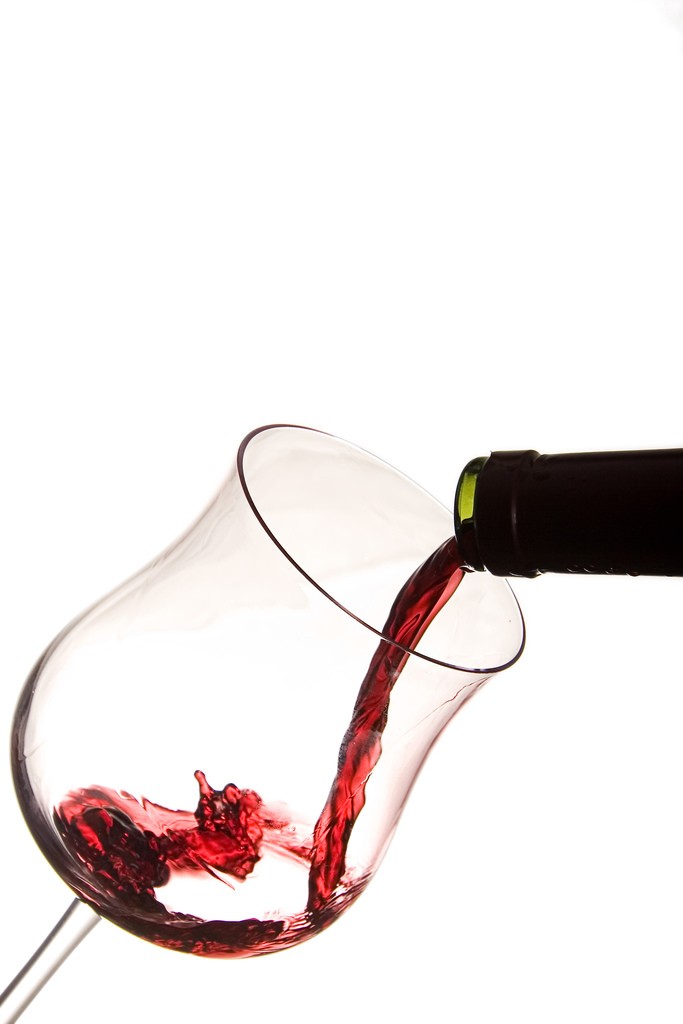
The joy of tasting the Riojas, Riberas and all the other great reds from Spain! photo credit: Jorge Lorte Copa de vino via photopin (license)
6 The Brands on a Wine List in Spain
Wine lists rarely display the label of the bottle (which is a pity as there are some fine examples worth rewarding with a purchase) so when you are looking at the wine list, you might be hoping to see familiar names such as Marques de Caceres, Marques de Riscal, Faustino, Torres, Cune, Campo Viejo, Paternina, Monte Real, Conde Valdemar and Coto de Imaz. We would recommend you use these wines as a pricing guide – rather than ordering them – use them to know where to position yourself on the wine list. If you usually drink a Marques de Riscal Reserva 2014 and see it on the wine list, aim for something around the same price that you can’t get at home. It might be a signature wine from the same winery or a wine from a completely different region. Ask your server for advice – mention what wines you like and let him or her help you try a brand or a wine that doesn’t export to the same level.
7 The Vintage & Alcohol Percentage
While ordering wine in Spain, you’ll rarely see the year of the wine provided on a wine list – but you will probably be told whether it is Joven, Crianza, Reserva or Gran Reserva. NB The phrase ‘barrica roble’ means ‘aged in oak barrels’.
In Spain, using the Rioja red & white wine ranking system as an example:-
• Vino Joven = less than 12 months old
• Crianza = Minimum 6 months aging in oak barrels for reds; whites and rosés must be aged for 6 months in oak barrels.
• Reserva = aged for three years with one of those in barrel. For whites, they must be 2 years with 6 months of that in oak barrels.
• Gran Reserva = minimum 18 months aging in the oak barrel and 3 – 3.5 years in the bottle. For whites and rosés, it should be 4 years of aging with 6 months of that in an oak barrel.
Cava operates on a different timeline:-
- Cava Blanco = 9+ months
- Cava Reserva =15+ months
- Cava Gran Reserva = 30+ months
- Cava Paraje Calificado = 36+ months
Of course, you can ask your serving staff for the year, called the ‘añada’ meaning harvest – if you want to try or avoid a particular vintage. For everyday meals, we would always opt for Crianzas and leave the fuller-bodied Reservas and Gran Reservas for special or weekend meals when you can take more time to enjoy their aging.
You’ll rarely be told the percentage of alcohol in the wines, but again, if this is a factor in your decision, do ask the waiting staff.

It’s not a bad job, is it? The team at Guia Peñin who rank Spain’s wines out of 100. Anything over 90 is well worth a try! Pic credit: Guia Peñin
8 Wine Points On the Wine List
Sometimes, while ordering wine in Spain, the wine list will provide a points score beside the wines. The best-known rating scheme in Spain is the Guía Peñín which rates wines out of 100 with anything over 90 being excellent and 95+ is exceptional. You might be interested in buying the guide in English (online or in hard copy format) for just 18 euro (price for the 2019 guide) here. Parker points are also sometimes quoted and also rate wines out of 100 with anything over 90 being outstanding and 96+ being extraordinary. If you don’t see any Parker Points on your ‘carta de vinos’ but would like to know what Parker recommends, you need to subscribe to the Wine Advocate for 99 USD which you can do here.
9 Price of Wine on the Wine List
The price of the wine is always provided on the wine list – in some places if it’s available by the glass this will also be indicated. The price will always include all sales taxes (known as IVA here). Service charges are also included but you can of course leave a gratuity for your meal. Read about tipping & gratuities in Spain here.
Clients often ask us about the mark-up of wines in restaurants in Spain and the truth is that the mark-up depends on the cost price of the bottle. Here is a rough example of the sliding scale many restaurants will apply (of course, each restaurant is at liberty to charge whatever they want):-
- If the bottle is bought by the restaurant for 5 euro, it will be priced around 10-15 euro on the wine list.
- If it costs 10 euro to the restaurant, it will be priced around 15-20 euro.
- If it costs the restaurant 20 euro, it will be priced anywhere from 25-35 euro.
- A bottle that costs over 50 euro will often be priced at 60-75 euro.
- NB Expensive bottles costing 250 euro and over might not be stored on the premises. The sommelier will have the local wine representatives on speed-dial to deliver whatever they need.
If the mark-up seems excessive, rest assured that you are probably paying a higher mark-up if you live outside Spain.
As a rule of thumb, when eating out, we would order a wine for 15 euro for a simple weekend meal. For a special occasion, we would go as far as 25-35 euro for a red wine and 20-25 for a white. If you can’t find a wine you’d like on the wine list, the easiest thing it to suggest a colour/grape/region you like and give the server a budget per bottle. In doing so, you’ve placed yourself in the hands of the restaurant – which is 99% of the time the best thing to do.
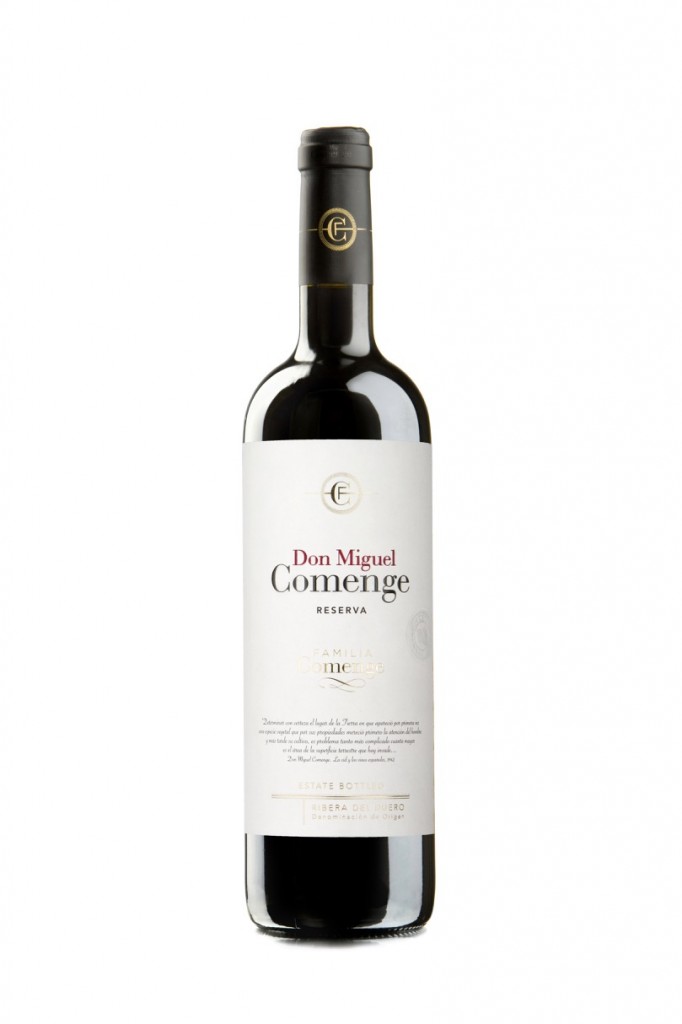
One of our favourite bottles from the Ribera del Duero – enjoy it in 0.75l or the Magnum. Pic credit: Comenge
10 Wine Bottle Size in Spain
The norm here is 750ml. Half bottles are very hard to come by in Spain. If you are drinking alone, we would recommend drinking by the glass or if you order a decent bottle, re-cork it and take whatever you don’t drink back with you to your hotel for a nightcap or to accompany a picnic the next day.
If you are dining with 4 or more people, you might want to check the wine list for magnums. Remember it often doesn’t cost less to drink by the magnum but wine is said to age better inside the 1.5 litre bottle than the 0.75l and, it’s great fun to see a Magnum on a table.
11 Tasting Menus with Accompanying Wines
Just like with our food, we tend to like the wine lists that are shorter (ie 4 pages max) and change frequently – that way you know the selection is up to date and it has an injection of personality from the chef, owner or sommelier. But when you are in the Michelin-star space, prepare for multiple pages – for example, Atrio in Caceres wine list is more like a publication than a list – 2018’s offering runs to 378 pages! That’s just one of the reasons we recommend booking in for a least one tasting menu (with accompanying wines per course) when in Spain. Take for example, in San Sebastian, Azurmendi’s tasting menu for 220 euro plus 127 euro per person for a selection of wines. Or in Madrid, Coque’s tasting menu of 195 euro plus 115 euro for wines. In Barcelona, you have lots of choice too – take for example Lasarte’s tasting menu for 245 euro plus 120 euro for wines. When you are there, try to make a note of the wines included (or ask the serving staff to copy you the list) and order some to be delivered to your home when you get back – wouldn’t they make wonderful gifts? And make the memory live long into the future.
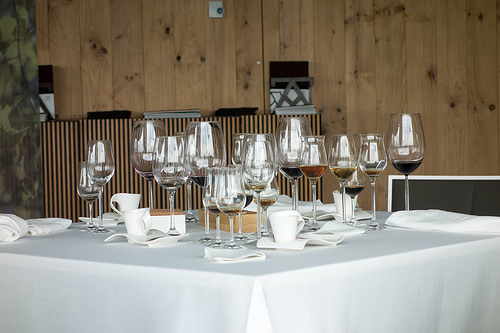
Seems like a lot of wine glasses on the go! photo credit: Kent Wang Azurmendi via photopin (license)
12 Special Dietary Requirements when ordering wine in Spain
It’s taken a while but we are beginning to see Spanish wineries producing organic, vegetarian and vegan-friendly wines but it’s not something you find on the average wine list. Again, kosher wine is produced in Spain but we’ve never seen it on a wine list. Although wine is generally gluten-free, some celiacs are caught out by wineries that use a flour or wheat paste to seal the barrels used in the ageing process. If this is something that might affect you, again we can arrange for guaranteed gluten-free wines to be available wherever you travel. It’s not common to find alcohol-free wine on a wine list but you will find alcohol-free beer everywhere.
If you need specialty wines or meals to be made available at your hotels and restaurants in Spain – rest assured we’ve done this many times for clients with vegan, alcohol-free, gluten-free, organic and kosher requirements. Check out our guide to eating vegan/vegetarian and gluten-free in Spain.
13 Wine Serving Miscellanea
- Wines are nearly always uncorked in Spain – rarely unscrewed. The local market hasn’t warmed to this trend.
- Unless you are eating somewhere very rustic, serving staff will ask somebody to try the wine before serving it.
- When being served, the Spanish will rarely fill a wine glass more than half way – so if you are drinking by the glass, don’t take it personally. You can indicate to the staff that you’d like a fuller glass but they may or may not pay attention to your request.
- If the wine is too hot or too cold, draw the waiter’s attention. In some regions, red wine is excessively chilled during the Summer months. Always request an ice bucket (un recipiente con hielo) for your bottle of white wine during warm weather.
- Everyday taverns get through so many glasses and crockery that they don’t always notice chips or cracks. If your glass is cracked, ask your waiter to replace it, before the wine is poured.
- It’s very unusual but if the wine is dreadful, you can ask your waiter for something else. You may be charged for both wines – but in our mind, there’s no point in suffering through a meal with terrible wine.
14 After Dinner Drinks on the Wine List in Spain
Digestifs might or might not appear on the wine list but they are always available. A rustic meal will call for an ‘orujo’ but if you‘re enjoying some fine dining, you’ll probably want something more elegant. Sweet wines such as Pedro Ximenez and ports. A quick word on brandy – if you usually drink cognac or Armagnac after a meal don’t be confused into ordering Spanish brandy which is a very different drink.
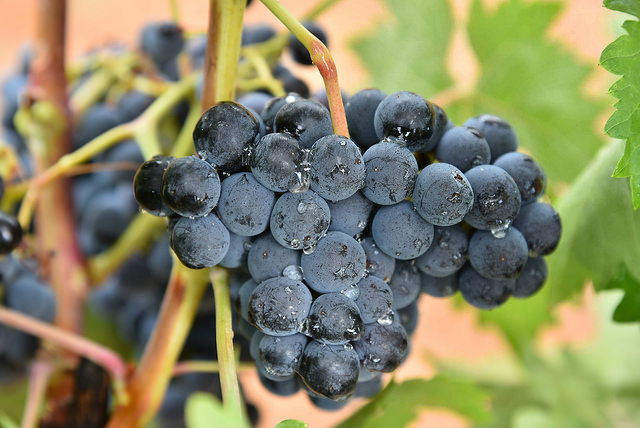
It looks like a simple bunch of ripened grapes but you can be sure that a lot of work has taken place already and much remains to be done to this bough from the Ribera de Duero. Pic credit: JI Berdón with the permission of the CRDO Ribera del Duero
15 Handy Tools/Apps for Enjoying and Ordering Wine in Spain
You might want to jot down some tasting notes on your wine Journey here in Spain. A trusty notebook helps as does an App such as Vivino which is handy for saving labels and checking out prices back home. And if you want to have some fun making tasting notes – why not print out a few of these Wine Folly tasting sheets to help you remember why you enjoyed certain wines.
16 Want to really enjoy the wine experience in Spain?
Book a custom tour with Totally Spain and we’ll arrange for you wine tastings, wine and food pairings, visits to wineries, meals at wineries and even hotels surrounded by vineyards. Check out our guides to the best wineries to visit, Rioja region, Rioja Alavesa region, Ribera del Duero and Jerez. And the best wineries with art. Plus a real wild card – a winery in Cantabria!
